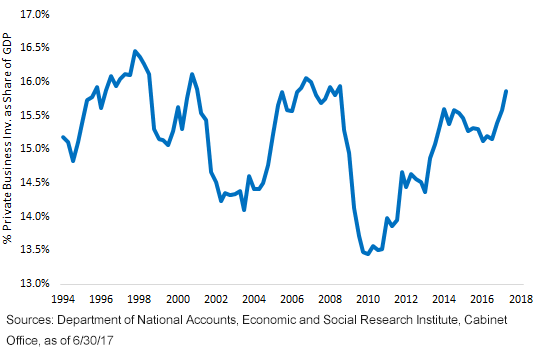Japan GDP: Into the Sweet Spot


The gross domestic product (GDP) report for April through June suggests that the Japanese economy has entered into a sweet spot, with growth accelerating and broadening into all components of domestic demand. While the 4% annualized GDP growth rate marks peak slingshot acceleration, the details of the report fully verify our thesis that Japan has entered a self-sustaining domestic demand-led up-cycle. Looking ahead toward 2018 and 2019, we maintain our call for 2% to 2.5% real GDP growth (and 3% to 3.5% nominal GDP growth). For policymakers, the margin for error on yen strength is eroding quickly.
Specifically, the Japan sweet spot for the second-quarter report is marked by the following:
- Positive wage and income dynamics
Workers’ compensation rose a strong 2.6%, pushing the absolute amount of workers’ compensation back up to levels last seen in 1998 and 1999. Unlike various monthly labor survey data, the compensation data of the GDP report combines the number of people employed with earnings received. Simply put, it is the best data reflecting the purchasing power of the Japanese people (although it excludes self-employed and public employees). More importantly, the upward trend in workers’ pay is structural, not merely cyclical. Japan’s demographic dynamics force a structural shift from part-time to full-time employment and a steady upward pressure on wages and incomes. While for the past two decades, excess employment put downward pressure on wages and forced headwinds against consumption, Japan’s labor shortages are now becoming reliable tailwinds for domestic demand.
Interestingly, consumer spending surged even more than workers’ compensation—consumption rose ¥2.5 trillion and compensation rose ¥1.7 trillion; this marks the first drop in the savings rate in over three years. We doubt that this is the start of a true reversal in Mr. & Mrs. Watanabe’s propensity to save, but it may suggest that household confidence in the sustainability of the employment up-cycle is starting to grow.
- Housing cycle still going strong
The structural improvement in employment quality—full-time employment has been accelerating steadily over the past 18 months, for the first time in basically 20 years—creates a strong foundation for rising household formation and, importantly, rising household sector leverage (because, de facto, part-time employees have no access to credit). Here, the GDP report confirms continued strength in residential investment, up 6%, for the sixth consecutive positive growth quarter. Again, we stress that Japan’s housing up-cycle is not merely cyclical but structural, a direct consequence of demographic dynamics, where household formation is now rising. At the same time, access to credit continues to ease as more banks enter the mortgage lending market—e.g., regional banks becoming active in major urban areas.
- Corporate “animal spirits” are back
Private capex (business investment) surged 9.9% for the eighth consecutive positive growth quarter. Although clearly there was a “tactical” surge in spending at the start of the new financial year, the structural forces demanding higher business investment are powerful: pressure is building to switch to more capital-intensive business models, particularly in the services sector; IT investment has fallen behind global competitors, particularly in financial services; the car and car-parts industry is forced to reinvent its production facilities because of electrification and “AI-ification”; the restart of nuclear power plants is restarting the utility plants’ replacement cycle, etc.—this is just to name a few of the capex demand drivers. Meanwhile, the combination of record-low interest rates and record-high corporate cash balances suggests no financial limits for added capex. If at all, the general rise in the rate of return on invested capital suggests it increasingly pays to invest.
- Investor focus—has capex peaked?
In our view, Japan’s business investment cycle has further to run. From here, we think the visibility of the capex cycle is likely to become the key leading indicator for our bullish Japan thesis in general, investor sentiment in particular.
Technically, it is tempting to call for an imminent capex slowdown. Capex is now back up to 15.9% of GDP—about a full percentage point higher than its long-term average; any level higher than 16% of GDP has been extremely rare and, more importantly, has never been sustained for long (see chart). Japan bears are likely to predict a downfall in capex. In contrast, we think that “this time is different,” with the structural drivers mentioned above likely to force a more sustained structural up-cycle in business investment. From here, machinery and construction orders, as well as growth data for corporate loans, will have to be scrutinized more carefully to determine whether the bulls or the bears are right.
- No room for policy complacency
Against our upbeat view on private demand, we expect public policymakers in general, “Team Abe” in particular, to leave nothing to chance. There is little risk of policy complacency. Of the 4% GDP surge, about one-third was a public demand boost. From here, this will normalize. The public sector drag on growth should come to around 1% in the coming quarters.
An added concern is the fact that exports actually dropped—down 1.9%, the first negative quarter in one year. This does raise possibly uncomfortable questions around Japan’s global competitiveness, particularly since the second quarter was one of general acceleration in global growth. More importantly, it raises the dangers that unchecked yen appreciation could bring. Compounding weak export volumes with yen appreciation risks tipping a first negative quarter into another one, for the start of a negative trend. In the latest earnings reports, many companies appear to be budgeting for ¥108 to ¥110 for the U.S. dollar, so the margin for error is getting squeezed quickly, in our view. Should the rise in geopolitical uncertainty continue to put upward pressure on the yen, a counter-response from Japanese policymakers potentially may be warranted.
Here, we maintain our view that the new Abe cabinet is likely to present added ease of fiscal policy, with a supplementary budget of around ¥5 trillion likely to be presented by October. For monetary policy, we expect no change from the Bank of Japan—the sweet spot in growth is anchored in steady productivity gains, and, more importantly, inflation remains more of a theoretical conundrum rather than a real-world threat. However, the real-world outlook could quickly be forced toward rising deflation risks by unchecked yen appreciation: every ¥10 of sustained yen appreciation cuts down Japan’s headline Consumer Price Index (CPI) by as much as 40 to 60 basis points (bps) (latest nationwide CPI was +0.4% year-over-year).
Japan Private Business Investment: Percentage Share in GDP

Important Risks Related to this Article
Investments focused in Japan increase the impact of events and developments associated with the region, which can adversely affect performance.

